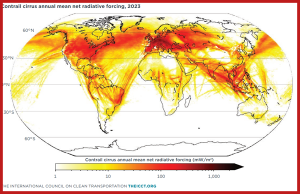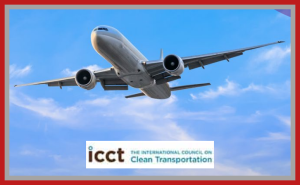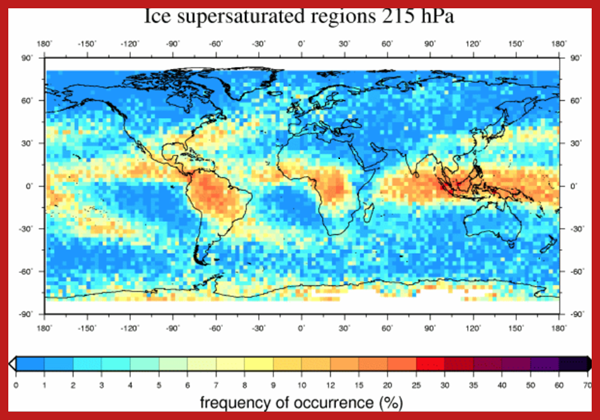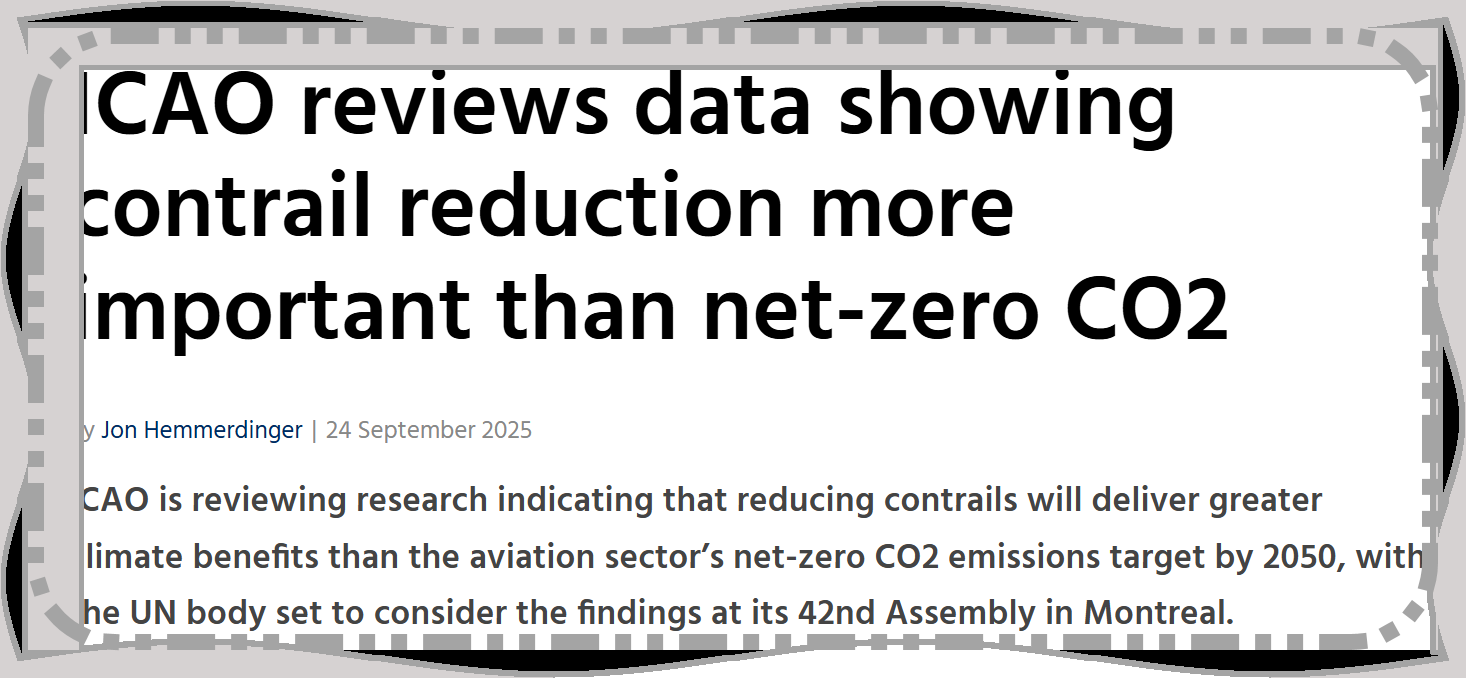ICAO #42 report says CONTRAIL policies may avoid >90% of aviation-induced warming by 2050 From EPA Acid Rain lesson time to review CORSIA
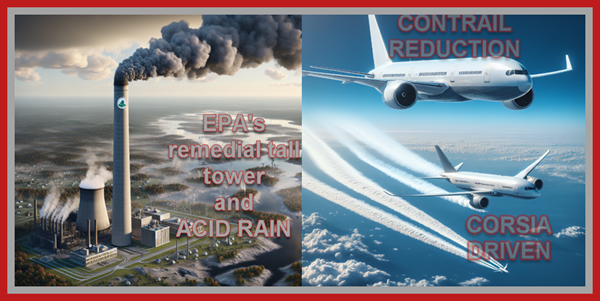
At the 42nd ICAO assembly, a potentially landmark, maybe even game changer, report was discussed- the International Council on Clean Transportation presented research postulating that contrail mitigation—not just CO₂ reduction—could be the most impactful lever for curbing aviation-induced warming.
The authors, Xinyi sola Zheng, Jayant Mukhopadhaya PH.D., Jonathan Benoit, Supraja n. Kumar, Dan Rutherford PH.D., Deniz Rhode and Daniel Sitompul documented their research and analysis over 73 pages.
A shift in Global Strategy Climate Neutral Growth to attacking CONTRAILs appears to be well supported by their work.
Environmental policy has driven by a threat[1] to impacts on the ecosystems and the health of living beings. The reactions to these threats have been identified and the responses defined URGENTLY.
Here is a case study that highlights the risks of quick answers to problems (see the left panel of the cover image):
-
In the 1970s–1980s, the U.S. Environmental Protection Agency encouraged or permitted taller smokestacks—often over 500 feet—for coal-fired power plants and industrial facilities.
-
The goal was local air quality improvement: by dispersing pollutants higher into the atmosphere, ground-level concentrations of sulfur dioxide (SO₂) and nitrogen oxides (NOₓ) would drop, reducing smog and respiratory harm near the source.
️ Unintended Consequence: Acid Rain
- Higher dispersion meant pollutants traveled hundreds of miles downwind before depositing.
- These airborne SO₂ and NOₓ compounds chemically transformed into sulfuric and nitric acid, falling as acid rain—damaging forests, lakes, and buildings, especially in the Northeast and Appalachia.
Legacy and Lessons
-
The tall smokestack era illustrates a classic regulatory tradeoff: solving one problem (local pollution) inadvertently worsened another (regional acid deposition).
This lesson demonstrates that environmental solutions must be vetted for systemic impacts. Both CORSIA and the Contrail Campaign portend to minimize aviation’s impact on the air.
- But does this identification of what appears to be a superior remediation a catalyst for a pause?
- Are the focused tactics for attacking CONTRAILS better than CORSIA’s longer list of actions?
- By reducing CONTRAILS does it impact some of the broader approach, for example, by reducing soot and water vapor emissions that seed contrails change the ideal chemical composition for SAF?
- By reducing soot and water vapor emissions that seed contrails, does that initiative result in even more CARBON REDUCTION?
- CORSIA allows some countries to avoid its more stringent requirements;
- Least Developed Countries (LDCs)
- Small Island Developing States (SIDS)
- Landlocked Developing Countries (LLDCs)
- Non-Volunteering States (until 2027)
►Ostensibly their lesser requirements reflect the COUNTRIES’ lower emission contributions, lesser economic basis and other points of differentiation. One of the most powerful CONTRAIL tactics involves the CARRIERS’s rerouting their aircraft to avoid ice-supersaturated regions (ISSRS) where persistent contrails form. If the LDC airlines, for example, do not avoid ISSRS, their flights will likely cause CONTRAILS and their flight path will probably burn less fuel (an economic benefit that disadvantages the ISSRS avoiding competitor).
None of this is intended to put research on hold. The time required to find sound solutions is LONG. Pursuit on cleaner fuel and/or powerplants that reduce emissions should be a present priority. An aspect of CORSIA with immediate impact in the Carbon Emissions Trading Scheme which airlines may need to purchase up to 150 million tonnes of carbon credits during Phase I (2024–2026), potentially costing between $1.3 billion and $8.4 billion, depending on whether credits or more expensive Sustainable Aviation Fuels (SAF) are used. This policy question should draw IMMEDIATE attention to this economic impact on the AIRLINES, not the ICAO MEMBER NATIONS.
This headline is atop of an article written by Jon Hemmerdinger for Flight Global. My subscription to this publication expired, but through AI we can create a poor, but useful substitute to Jon’s erudite paper (Copilot cited sources–Greenhouse gas controls alone won’t align aviation with the Paris Agreement; Why contrails could be key to climate neutral growth – for now; Climate Change).
“At ICAO’s 42nd Assembly in Montreal (September 2025), policymakers reviewed new modeling from the International Council on Clean Transportation (ICCT) SHOWING THAT CONTRAIL MITIGATION—NOT JUST CO₂ REDUCTION—COULD BE THE MOST IMPACTFUL LEVER FOR CURBING AVIATION-INDUCED WARMING.
✈️ Key Findings from the ICCT Report
- Contrails account for ~40% of avoidable warming by 2050, more than any other single measure, including sustainable aviation fuels (SAFs).
- CO₂ represents only half of aviation’s climate impact; the other half comes from short-lived climate pollutants (SLCPs) like contrails, NOₓ, and black carbon.
- Contrail avoidance is fast-acting: Unlike CO₂, which persists for centuries, contrails dissipate quickly, making them a prime target for near-term climate benefits.
- Combined SLCP and GHG mitigation COULD SLASH AVIATION WARMING BY 90% THROUGH 2050, aligning with the Paris Agreement’s 1.5°C goal.
ICAO’s Policy Implications
- ICAO’s current long-term goal is net-zero CO₂ by 2050, adopted in 2022.
- The new data has prompted debate over ADDING SLCP TARGETS, ESPECIALLY FOR CONTRAILS, to ICAO’s climate roadmap.
- OPERATIONAL CHANGES—like rerouting flights to avoid contrail-prone altitudes—are seen as low-cost, high-impact interventions.
This marks a pivotal moment where ICAO may evolve from a CO₂-centric framework to a more holistic climate strategy.
=======================================================================================================
Here’s a breakdown of key stakeholder positions from ICAO’s 42nd Assembly (Montreal, Sept 23–Oct 3, 2025) regarding contrail mitigation and broader climate strategy:
International Coalition for Sustainable Aviation (ICSA)
- Position: Strongly advocates for integrating short-lived climate pollutant (SLCP) controls—especially contrails—into ICAO’s climate roadmap.
- Proposal: Updated its Vision 2050 to include SLCP mitigation alongside CO₂ reduction.
- Rationale: ICCT modeling shows that combined SLCP and GHG controls could avoid >90% of aviation-induced warming by 2050.
International Air Transport Association (IATA)
- Position: Focused on scaling sustainable aviation fuel (SAF) production and defending CORSIA as the primary market-based measure.
- Contrail stance: LESS VOCAL ON SLCPS; prioritizes SAF incentives and global standards over operational changes like contrail avoidance.
- Concerns: Warns against FRAGMENTED national regulations and tax schemes that could undermine global aviation efficiency.
ICAO Secretariat & Member States
- Position: Reviewing SLCP science but cautious about shifting from the 2022 Long-Term Aspirational Goal (LTAG) of net-zero CO₂ by 2050.
- Debate: Whether to supplement LTAG with SLCP targets or operational guidance on contrail avoidance.
- Next steps: Working papers (e.g., A42-WP/384, A42-WP/385) propose frameworks for integrating SLCPs into ICAO’s environmental work program.
ICCT (Technical Advisor)
- Position: Urges ICAO to act on contrail science, calling it “low-hanging fruit” for near-term climate gains.
- Findings: Contrail avoidance alone COULD DELIVER 40% OF TOTAL AVOIDED WARMING BY 2050.
- Critique: Governments are underprioritizing SLCPs despite their outsized impact.
===========================================================================================
HOW THE CONTRAIL REDUCTION STRATEGY MIGHT BE IMPLEMENTED:
1. Operational Avoidance via Flight Planning
- Concept: REROUTE AIRCRAFT TO AVOID ICE-SUPERSATURATED REGIONS (ISSRS) WHERE PERSISTENT CONTRAILS FORM.
- Tools: Real-time meteorological data + predictive models (e.g., EUROCONTROL’s prototype contrail forecast tool).
- Implementation:
- Airlines integrate contrail risk into flight planning software.
- Prioritize rerouting during high-impact flights (e.g., night-time, high-traffic corridors).
- Challenges: Balancing fuel burn tradeoffs, airspace congestion, and ATC coordination.
2. Contrail Forecasting Systems
- Concept: Develop global, high-resolution contrail prediction models.
- Examples:
- NASA’s Contrail Avoidance System (CAS) prototype.
- DLR (Germany) and JAXA (Japan) regional models.
- Use Case: Feed into airline dispatch centers and ATC systems for proactive routing.
3. Engine and Fuel Modifications
- Goal: REDUCE SOOT AND WATER VAPOR EMISSIONS THAT SEED CONTRAILS.
- Strategies:
- Use low-aromatic SAF blends to cut particulate matter.
- Explore water injection or lean-burn combustors to lower contrail-forming emissions.
- Status: Experimental; ICAO’s Committee on Aviation Environmental Protection (CAEP) is reviewing lifecycle impacts.
4. Regulatory and Incentive Frameworks
- ICAO Pathways:
- Add SLCPs (including contrails) to ICAO’s environmental work program.
- Develop guidance material for member states and operators.
- National Initiatives:
- EU considering contrail metrics in ETS Phase IV.
- FAA exploring voluntary contrail avoidance trials with U.S. carriers.
5. Monitoring and Reporting
- Concept: Track contrail formation and avoidance success.
- Methods:
- Satellite imagery (e.g., MODIS, Sentinel-5P).
- ADS-B data + onboard sensors.
- Goal: Build a global contrail inventory to inform policy and refine models.
KEY TAKEAWAYS
- Operational avoidance is the most immediately impactful and cost-effective strategy, with ICAO and EUROCONTROL trials showing up to 40% warming reduction from contrail rerouting alone.
- Forecasting systems are critical enablers but require global coordination and high-resolution data to be effective.
- Engine and fuel changes offer long-term benefits but face high costs and long certification timelines.
- Regulatory frameworks (e.g., SLCP inclusion in ICAO’s LTAG) could accelerate adoption but require consensus among member states.
- Monitoring/reporting is essential for verification and policy design but doesn’t reduce warming directly.
[1] Not all agree with this conclusion. Addressing that critique would require writing a book of thousands of pages. Not here, however.
